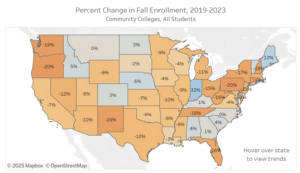
The Trends
Community colleges are still facing an uphill battle in restoring enrollment rates to pre-pandemic levels. A recent report by the Community College Research Center (CCRC) at Columbia University highlights a concerning trend in enrollment among the nation’s community colleges, based on newly released numbers from the federal Integrated Postsecondary Education Data System (IPEDS).
According to CCRC, less than one third (27%) of the 931 studied institutions fully recovered their enrollment numbers from fall 2019 to fall 2023. In Delaware, New Hampshire, Rhode Island, Washington, Massachusetts, Pennsylvania, and Tennessee, fewer than one in ten community colleges reached pre-pandemic enrollment rates. On the other end of the spectrum, North Dakota, Nebraska, Maine, Colorado, Alabama, Indiana, and Vermont saw more than half of their institutions completely rebound. IPEDS’ data indicates that community colleges in 21 states faced a 10% or greater decline in enrollment between 2019 and 2023.
While these statistics are concerning, there has been slow but steady growth in national enrollment rates since the peak of COVID-19. In 2023, over six million students registered for community college courses, a rise from 2021’s pandemic low of 5.74 million. Current numbers still fall short of the 6.59 million enrolled in 2019, and the disparity is even greater when compared to the 7.19 million enrolled in 2013.
IPEDS’ numbers also reveal significant trends by age groups. From 2019 to 2023, every state except South Carolina experienced a decline in the number of older adult learners (defined as 25 years or older) who enrolled in community colleges. Similarly, every state except Maine had drops in recent high school graduates (age 18-24). In the past few years, these two outliers – Maine and South Carolina – have been acknowledged for establishing and maintaining a strong push for two-year educational institutions and community colleges, with efforts including free tuition policies, expansions for career and technical programs, and integrated pathways starting in high school.
The data also showcases the growing presence of dual enrollment students, rising from just over one million in fall of 2019 to 1.31 million in fall of 2023, a 26% increase. Across the nation, almost three out of four community colleges experienced this trend, with more and more learners choosing to take dual enrollment courses in high school. At community colleges and two-year educational institutions, dual enrollment students now comprise more than 20% of total enrollments.
The Takeaways
Recent patterns in enrollment across the community college system highlight continued challenges in the COVID’s aftermath. However, IPEDS’ data offers guidance for potential solutions to recover and even exceed pre-pandemic levels. The high proportion of dual enrollment students prompts a need for expanded pathway programs, more readily available coursework and advising services, and focused partnerships between secondary educational institutions and community colleges. Beyond this trend, the rapid decline in enrollment rates for older adult learners and recent high school graduates suggest gaps in current recruitment and support efforts. Modeling the states and institutions that have recovered or surpassed pre-pandemic numbers may offer struggling community colleges concrete strategies for strengthening enrollment rates.
CCRC has published interactive dashboards for visualization of IPEDS’ newly released data, with options to filter by timeframe, student population, and location. Read the full report by CCRC and check out national or local trends in enrollment here.
 Subscribe
Subscribe


 See More ATE Impacts
See More ATE Impacts
Comments
There are no comments yet for this entry. Please Log In to post one.